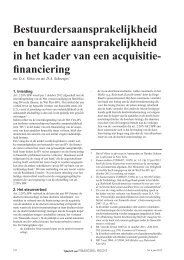Life Sciences Outlook 2012 Dutch biotech companies ... - NautaDutilh
Life Sciences Outlook 2012 Dutch biotech companies ... - NautaDutilh
Life Sciences Outlook 2012 Dutch biotech companies ... - NautaDutilh
Create successful ePaper yourself
Turn your PDF publications into a flip-book with our unique Google optimized e-Paper software.
The term ‘strategic alliance’ is “largely window<br />
dressing”; the relationships are in reality quite<br />
skewed, with power being in the hands of the party<br />
with the money. “Big Pharma is not in the business<br />
of paying milestones. The only certain payment is<br />
the upfront payment, which is usually quite low.<br />
Subsequent milestone payments may get stalled or<br />
bogged down in legal battles.” Structuring the terms<br />
of an alliance and potential equity investments is<br />
obviously key (See box).<br />
<strong>companies</strong> are then freed up and can put their talent<br />
and experience to use in new ventures.<br />
There are, however, downsides to such an<br />
ecosystem. “In the Netherlands we will end up with<br />
many small <strong>biotech</strong> <strong>companies</strong>. In this way we<br />
are not going to build new Crucells here,” is how<br />
one interviewee puts it. From a national economic<br />
perspective, this means a lack of sufficiently mature<br />
<strong>companies</strong> that generate taxable income, exports<br />
The end result of a strategic alliance and collaboration, but also of equity investments and exits, will<br />
of course depend on the bargaining power of the parties involved and the competitive field. Clearly, a<br />
company with urgent financing needs will often reach a worse deal than a strong independent player with<br />
no need for a sale or alliance. From the company’s perspective it is key to structure deals so as to get the<br />
benefits in the desired terms (upfront & milestone payments), while not bargaining the company away for<br />
too little. This could be achieved, for instance, by limiting the scope of an alliance (to certain regions, parts<br />
of the portfolio or indications only), by being very careful in agreeing to co-finance the products under<br />
penalty of losing the product, and by agreeing appropriate termination provisions allowing the company<br />
to regain control and a new future if the partnership for whatever reason does not work out. It may indeed<br />
occur that the partner changes its strategy and decides not to acquire control over the company even if it<br />
was planning to do so before. The company is well-advised to have made allowance for that situation in the<br />
termination provisions, including by having a repurchase option for any equity held by the partner.<br />
30<br />
Implications<br />
The ecosystem described above perhaps reflects<br />
– in an ideal world – the most efficient allocation<br />
of means: agile, focused <strong>biotech</strong>s quickly take<br />
scientific ideas and discoveries through the initial<br />
phases of development. Professional investors select<br />
the ones most likely to succeed, provide capital<br />
and managerial support and broker deals with Big<br />
Pharma. Big Pharma offers good exit opportunities,<br />
takes new products through the final phases<br />
of development and applies its marketing and<br />
distribution power to create successful market entry.<br />
Often management and scientific staff of <strong>biotech</strong><br />
and self-supporting business for the long run.<br />
For the sector itself, the risk associated with this<br />
development is that in the longer term, and in the<br />
absence of Big Pharma that has R&D and business<br />
development activities here, there will be a lack of<br />
people who have first-hand experience in building an<br />
(independent) <strong>biotech</strong> company, taking a company<br />
public or bringing new products to the market.<br />
“You must have occasional success stories! Only<br />
then can you attract the people and the capital you<br />
need to sustain a vibrant, growing <strong>biotech</strong> sector,”<br />
stresses one interviewee, again echoing several<br />
others.















